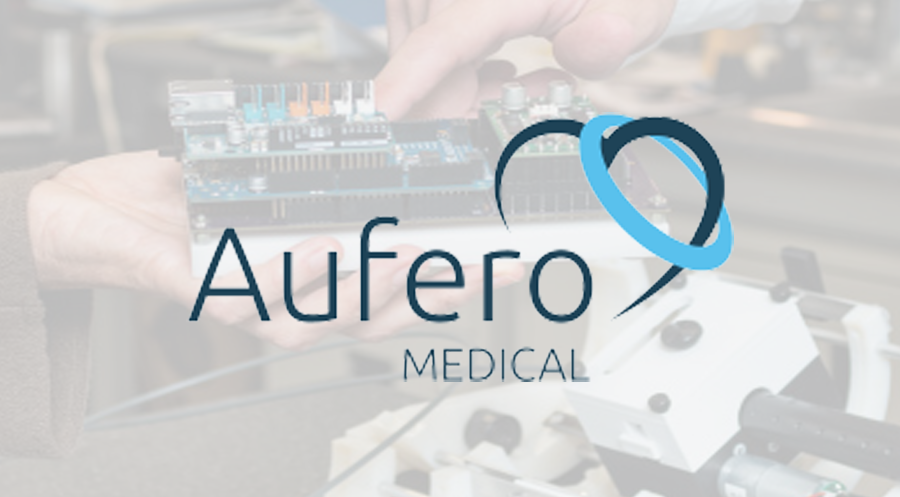CANet and Aufero Medical work together to provide stability in patient care
“Patient care has motivated me to become what I am today,” says Daniel Gelman, CEO of Aufero Medical.
That passion and belief have guided the electrical and biomedical engineer over the past seven years to pioneer a device to help treat the most common and clinically significant form of heart arrhythmia – atrial fibrillation.
Aufero Medical’s technology stabilizes the point of contact between a catheter – the medical device used to treat arrhythmia – and inside of the heart wall.
“I truly believe that our technology is going to impact patient lives significantly,” he says.
Heart chambers, called atria, generate electrical signals that eventually produce heartbeats. Diseased atria may result in rapid, irregular heartbeats known as atrial fibrillation (AF). Patients with AF have an increased risk of stroke and often complain of chest pain, shortness of breath, light-headedness, and palpitations.
Doctors typically treat AF by inserting a thin, long and flexible device (catheter) into the heart and deliver high-energy radiofrequency waves to burn (ablate) the diseased tissues.
The method is not always successful.
Gelman noticed a problem around 2014-2015 during his Ph.D. studies.
“During ablation procedures, it was challenging for physicians to maintain stable contact between the catheter tip and moving heart wall,” he recalls.
In up to half of all such ablation procedures in Canada, patients return for a second or third repeat treatment. This costs Canadian taxpayers estimated to be $170M per year. These figures are estimated to increase 2-4 fold by 2050.
To solve this, Gelman invented, and with CANet’s support, improved, the Contact-Force Catheter (CFC). It actively stabilizes the contact the catheter makes between the tip and tissue. Gelman’s work makes AF treatments more effective, reduces repeat procedures, and ultimately lowers healthcare costs. It also reduces patients’ dependence on anti-arrhythmic drugs, which can be ineffective, with often severe side-effects such as heart failure or organ toxicity.
The CANet-funded technology is one of the many ways the organization is working towards reducing AF hospitalization and emergency department visits by 20 percent. Helping provide effective, efficient, and accessible arrhythmia care in Canada and worldwide.
“CANet has always helped me along every step of my journey,” Gelman says.
During his Ph.D., Gelman joined CANet’s network as a trainee. The organization invested time, funding, and mentorship, cultivating him as one of Canada’s next generation of arrhythmia research and management investigators.
“If you are passionate in this field and have an idea to improve patient care, CANet is an arm’s length away,” he says.
When Gelman developed the initial prototype of his device in 2014-15 and successfully demonstrated its ability to stabilize the contact between tip and tissue in a lab setting, CANet awarded him a $25,000 Discovery to fund pre-clinical studies.
“That grant helped me collaborate with Biosense Webster, a medical device company, to test the CFC prototype in beating heart,” he says.
The grant also helped Gelman establish Aufero Medical, a medical device start-up in London, Ontario, to commercialize CFC, and in the process, create jobs and benefit the Canadian economy.
Shortly after, Gelman and Aufero won a CANet Commercializing Grant totalling $300,000.
“This was a huge turning point for us,” he says. “Those funds were mainly used to work with a professional medical device design and development firm. That collaboration helped transform the initial proof-of-concept device to a clinically viably solution.”
During this time, Gelman worked with a group of CANet electrophysiologists who helped refine the design and function of the CFC to make it ideal for clinical use.
“What CANet has provided, apart from funding, has been invaluable – mentorship, validation, partnership, and outreach with a robust network of electrophysiologists in the country,” Gelman says.
Competing against three other finalists, Gelman and Aufero Medical won CANet’s SHIFT competition, receiving the first-place prize of $200,000, helping accelerate product development and commercialization of the CFC.
With the recent funding, Aufero has expanded. The team is designing and developing the device according to Health Canada and Federal Drug Agency regulations.
Critically, the device will be undergoing first-in-human clinical trials starting in 2022 in collaboration with Western University.
“I am excited about our future relationship with CANet,” Gelman says. “CANet is working towards facilitating future multi-centre clinical trials and will be very active in the validation of CFC.”
Gelman hopes to start recruiting patients next year. There are already several CANet electrophysiologists who want to be involved in the first clinical trial study.
“CANet is the country’s one single voice that focuses on research and development in arrhythmia, and it is a powerful brand in the field,” Gelman says.
That brand recognition, according to him, has given Aufero critical visibility in Ontario. He mentions that the CANet logo helps validate Aufero’s effort and provides a vital opportunity for other funding agencies, venture capitalists, and strategic partners to support the technology and help Aufero reach milestones. Working with CANet, allows Gelman and Aufero to get closer to the commercialization of a new product that can help Canadians and patients worldwide.
He is grateful and hopeful.
“Nothing will make me happier than seeing my technology being used in patients,” Gelman says. “I do not want to see a potentially life-saving technology stagnate at the research level – I want to see it in the hands of electrophysiologists and help them treat patients with the best of care.”

